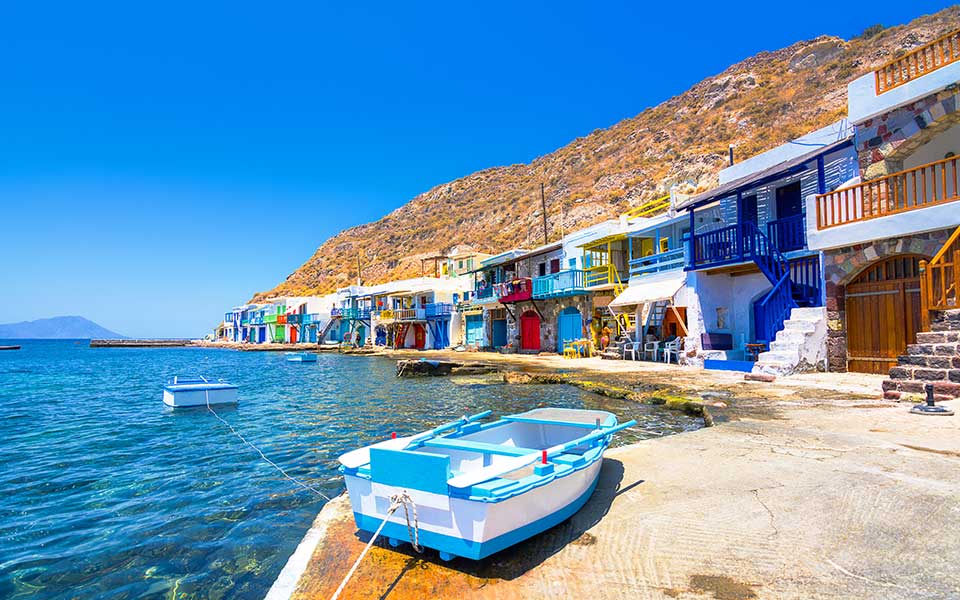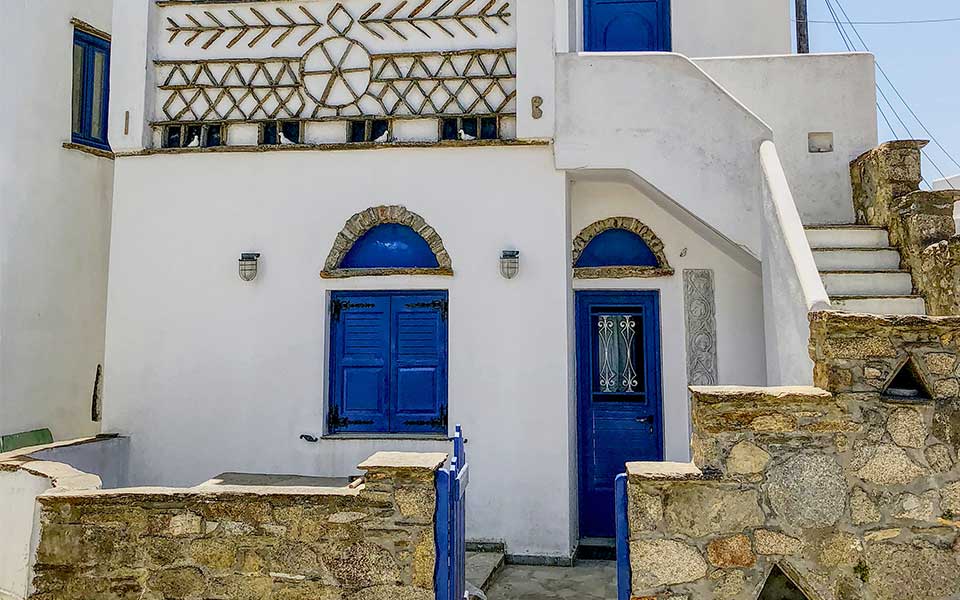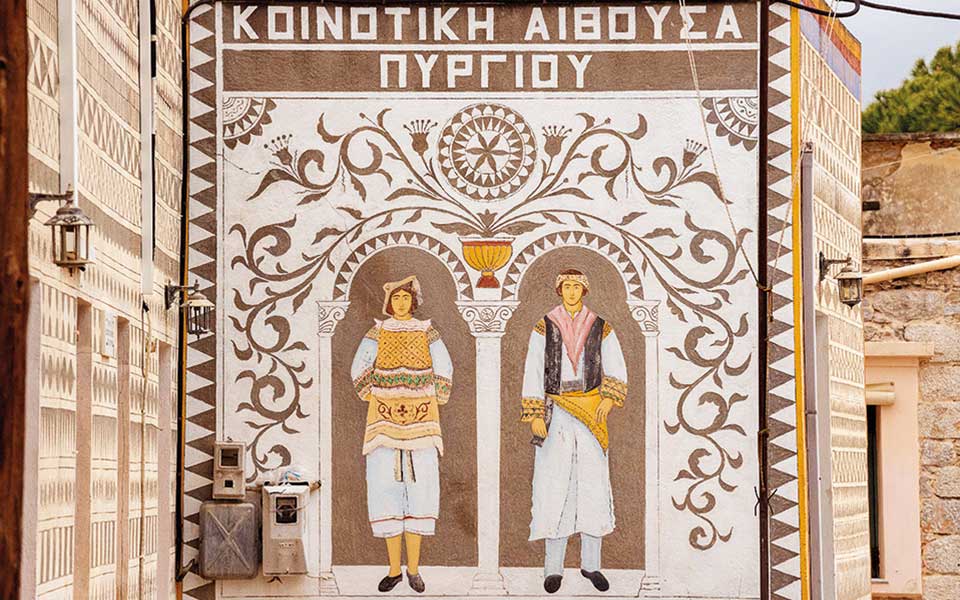A Delicious Guide to Ios
Your summer map to Ios: what...

Klima, Milos
© Shutterstock
In the early 19th century, a farmer in Klima, Milos, unearthed a female statue that became famous as the Venus de Milo. However, photos of this fishing village are now making the rounds on Instagram for different reasons. Klima, a small seaside settlement with only a handful of residents, is renowned for its beautiful cave-like “syrmata” houses. These unique Cycladic structures, carved into the rock and also found elsewhere on the island, were initially built as storehouses for the fishermen’s boats during the winter. They take their name from the ropes (syrmata) they would use to haul them inside and protect them from storms.

In Klima, the syrmata have two levels. The ground floor was used to store boats, while the first floor housed the fishermen’s families. Today, however, many of these white structures operate as lodgings. Klima, a lovely village about 5 kilometers from Adamas and 3 kilometers from Plaka, is also famed for its breathtaking sunsets and now attracts visitors from all over the world. Many people come not only to wander and take photos in front of the syrmata with their large wooden doors and brightly colored balconies but also to spend their vacation there.
If you visit Milos this year, look for the few remaining fishermen in this picture-perfect village and visit the cave chapel of Agia Paraskevi on the outskirts of town. Between Klima and Tripiti, you’ll find the Ancient Theatre of Milos and the famed Catacombs, an ancient underground communal cemetery that is regarded as one of the world’s most important early Christian monuments.

Volax, Tinos
© Marika Tsouderou
Volax has recently become connected with poetry, as it welcomes guests with verses by Greek poets on its doors, windows, and walls. This year, it will host the 10th Tinos International Literary Festival from July 24 to 27. However, the reason why this Cycladic village is unique throughout the world is very different.
Whether they are the remains of battles between Titans and Giants, as local legend has it, or of a meteorite fall or volcanic eruption millions of years ago, as some theories suggest, the enormous granite boulders surrounding the village create an otherworldly landscape. These “volaki,” from which the village derives its name, have elevated the plateau around Volax to international prominence as a bouldering destination. Rock climbers from all over the world come to the island to climb the amazing, almost spherical rocks that resemble man-made sculptures.

Volax, Tinos
© Shutterstock
Aside from the unique monoliths that continue to fascinate geologists, this basket-weaving village in the heart of Tinos is one of the island’s oldest and houses a small but well-curated folklore museum with fascinating exhibits from the region’s agricultural and ecclesiastical life in the nineteenth century. Volax also serves as the starting point for numerous beautiful hiking paths, including the Water and Castle Route, which passes through Agapi, Perastra, and Exomvourgo before returning to Volax, and the circular Geotrail, which passes through Falatados and Myrsini before circling back to the village. If you visit Tinos during the summer, you’re likely to catch an event at the village’s outdoor stone theater, and if you happen to be there on September 9, when the parish celebrates the Nativity of the Virgin Mary, you’ll see Volax at its finest.

Pyrgi, Chios
© Nikos Boutsikos/Nidibou Photography
Although the residents of Pyrgi may not appreciate this somewhat satirical little ditty, it is a testament to their pride in their unique village, which continues to be a subject of study to this day. Pyrgians were distinguished from other Chios residents a few decades ago by their distinctive traditional costumes and dialect. Although they no longer wear white clothes and turbans, their strong Cypriot-like dialect still gives them away. However, what makes Pyrgi of Chios really stand out is the technique used to decorate the exterior of the buildings within the village’s medieval fortifications. This gorgeous mastic village resembles an open-air museum because of its unique black-and-white geometric patterns made up of circles, lozenges, triangles, stars, and other shapes.

Pyrgi, Chios
© Nikos Boutsikos/Nidibou Photography

Pyrgi, Chios
© Nikos Boutsikos/Nidibou Photography
These designs, known as “xysta,” are formed by layering white and gray plaster and resemble Renaissance Italian sgrafitti. They are a unique art form that impresses both Greek and international visitors. The village comes alive on August 15, when Pyrgians from all over congregate in the square to celebrate the festival of the Virgin Mary. Pyrgi’s festivals attract many visitors who come to watch the locals dance the Pyrgian, a fast dance performed by three dancers: two men and a woman in the middle.
If you visit Chios this summer, head to the southwest to admire the architecture and decoration of these unique houses. In Pyrgi, you’ll also come across several historic churches, such as the 13th-century Byzantine church of the Holy Apostles. The Chios Mastic Museum of the Piraeus Bank Group Cultural Foundation is about 2.5 kilometers away, and two of the island’s most impressive beaches are nearby: Mavra Volia, with its black volcanic pebbles, and the beautiful Vroulidia, a small sandy beach next to spectacular white cliffs with turquoise waters and a view of the Venetiko island.
Your summer map to Ios: what...
Shady hiking trails, a vibrant cultural...
From Samos to Crete, we've selected...
Discover Greece’s islands in September with...